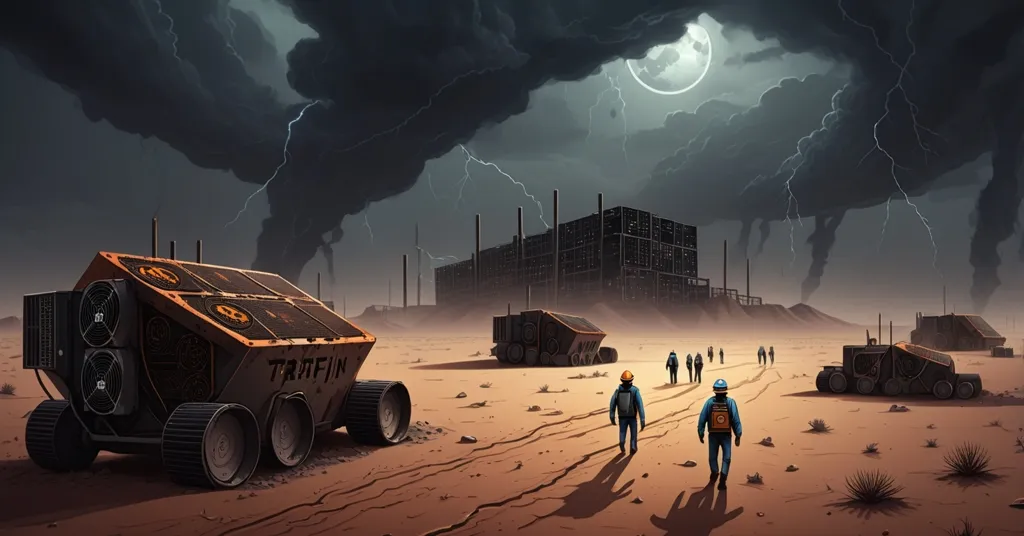Bitcoin Miners Flee to AI as Trump Tariffs and 2028 Halving Threaten Industry Collapse

Bitcoin Miners Pivot to AI as Trump Tariffs Slam BTC Price and Halving Threatens Collapse
Bitcoin miners are facing an unprecedented crisis in 2025, battered by plummeting BTC prices due to Trump-era tariffs, skyrocketing operational costs, and a regulatory crackdown that’s tightening the noose. With the 2028 halving on the horizon threatening to gut block rewards, many are fleeing to the promised land of artificial intelligence (AI) and high-performance computing (HPC), raising billions for data centers while dumping their Bitcoin holdings. This mass exodus raises a critical question: can Bitcoin’s decentralized foundation survive when its core protectors abandon ship?
- Price Meltdown: Trump tariffs drive BTC value to mining breakeven levels.
- AI Lifeline: Miners like TeraWulf and CleanSpark bet billions on data centers.
- Regulatory Fire: ICE raids and Bitmain scrutiny expose geopolitical risks.
A Perfect Storm: Tariffs, Difficulty, and Desperation
Bitcoin mining is in a dire state right now, and there’s no sugarcoating it. The return of Trump-era tariffs has obliterated BTC’s market price, pushing it so close to the average cost of mining that many operations are hemorrhaging money. Picture this: you’ve invested millions in hardware and energy, only to see the value of your product tank while your bills keep climbing. That’s the nightmare miners are living. To make matters worse, mining difficulty—how tough it is to solve the cryptographic puzzles needed to mine a block—surged by 5% in early October 2025, the seventh consecutive rise. Meanwhile, the network’s total hashrate, a measure of computing power dedicated to mining, is nearing a mind-boggling 1.1 zettahashes per second (ZH/s) as of late September. More miners with beefier rigs are fighting over the same shrinking rewards, driving energy costs through the roof.
The desperation is palpable. Miners are liquidating their Bitcoin at an alarming rate, with CryptoQuant data showing 51,000 BTC—equivalent to about $5.6 billion—flooding exchanges from miner wallets. That’s not just a cash grab; it’s a survival tactic to pay for electricity and keep operations running. And don’t expect transaction fees to save the day. These fees, which miners earn for processing transactions on the Bitcoin network, are supposed to cushion the blow as block rewards (new BTC earned per block) decrease over time. But they’re practically nonexistent. Why? Most BTC isn’t being used for everyday payments. It’s held by corporate treasuries and ETF managers as a speculative asset, not a currency. This hoarding cripples transaction volume, leaving miners with no fallback as their primary income source dries up.
Production Woes: Numbers Don’t Lie
The latest production reports from September 2025 are a stark reminder of the industry’s struggle. Even as miners pour more computing power into the network, their Bitcoin output is often declining. CleanSpark mined just 629 BTC, down from 657, despite a hashrate of 45.6 exahashes per second (EH/s—a smaller unit of hashrate). Riot Platforms dropped to 445 BTC from 478 with a 32.2 EH/s hashrate. BitFuFu took a hard hit, falling from 408 to 329 BTC. MARA Holdings, boasting the largest miner treasury at 52,850 BTC, nudged up slightly to 736 from 705, but even they’re not immune to the pressure. These figures scream one thing: cranking up computational power isn’t paying off when difficulty spikes and BTC’s market value is in the toilet. Miners are burning cash just to stay in the game.
AI Escape Hatch: Trading Pickaxes for Data Goldmines
With margins thinner than a paper cut, miners are ditching the crypto grind for the more stable profits of AI and HPC. These sectors, driven by the global hunger for data processing power, promise a steadier paycheck than Bitcoin’s wild price swings. CleanSpark secured $200 million in Bitcoin-backed credit from Coinbase Prime and Two Prime Lending to fund both mining and AI facilities. Cipher Mining upsized a debt issue to $1.1 billion for a Texas data center. TeraWulf went nuclear with a $3.2 billion debt offering for a New York expansion. IREN closed a $1 billion deal, and Bitfarms launched a $300 million offering, both zeroing in on AI infrastructure. Galaxy Digital pulled in $460 million for its Helios data center, explicitly stepping away from BTC mining. This isn’t a side gig—it’s a full-scale retreat, backed by billions, signaling a belief that AI’s computational demands will outlast Bitcoin’s volatility.
But let’s not kid ourselves—this pivot isn’t all sunshine and rainbows. Bitcoin’s security hinges on miners validating transactions and maintaining the blockchain. If they morph into AI giants, who’s guarding the fort? Are we swapping Wall Street’s centralization for a new breed of corporate data empires? Some miners aren’t just pivoting; they’re jumping ship entirely. Bit Digital sold off its rigs to become an Ethereum-based treasury firm, with CEO Sam Tabar unleashing a scathing verdict on the industry.
“Realized, and I think the other miners are finally realizing this, that [mining] is a very shitty business,” Tabar said.
He doubled down with a grim forecast for the 2028 halving, when block rewards will plummet to a measly 1.5625 BTC per block.
“Bitcoin mining industry is going to be dead in two years,” Tabar warned.
His reasoning is brutal but logical: without significant transaction fee revenue, only state-backed entities with access to subsidized energy can weather such pathetic margins. It’s a gut punch to anyone who sees mining as the heart of Bitcoin’s decentralization.
Regulatory Hell: Raids, Geopolitics, and Bitmain’s Shadow
As if financial ruin wasn’t enough, regulators are piling on the pain. On September 29, 2025, a joint operation by Immigration and Customs Enforcement (ICE), the FBI, Homeland Security Investigations (HSI), and the Texas Department of Public Safety raided the Lonestar Dream Bitcoin facility in Pyote, Texas. Chinese nationals with expired visas were detained, raising red flags about immigration violations. The facility, tied to Bitmain—the Chinese behemoth controlling 90% of the market for ASICs (specialized hardware built solely for Bitcoin mining)—through a tangled web involving ADW Tech and China Green Agriculture, is also under scrutiny for potentially evading U.S. export controls on advanced chips via Xiamen Sophgo Technologies. For those new to the term, export controls are restrictions on shipping sensitive technology, like cutting-edge semiconductors, to geopolitical rivals like China, often used as leverage in trade disputes.
The plot thickens with American Bitcoin Corp, a Hut 8 spinoff co-founded by Donald Trump’s sons, drawing heat for controversial deals with Bitmain. CEO Michael Ho has defended the ASIC purchases, but the optics of mixing crypto, geopolitics, and family connections are messier than a crashed exchange. Bitcoin mining, once a symbol of rebellion against centralized systems, is now caught in the crosshairs of global power struggles. Could this regulatory storm drive mining to more hospitable regions like Kazakhstan or Iceland, where energy is dirt cheap and politics less suffocating? Or does it spell the end of the decentralized mining dream, leaving only well-connected corporates standing?
Halving Nightmare: A Ticking Time Bomb
Looming over all of this is the 2028 halving, a built-in Bitcoin mechanism that slashes block rewards in half roughly every four years to cap the total supply at 21 million coins. Historically, halvings in 2012, 2016, and 2020 cut rewards from 50 to 25, then 12.5, then 6.25 BTC per block. Miners adapted through rising BTC prices and efficiency gains. But with 2028 dropping rewards to just 1.5625 BTC, and transaction fees still a pipe dream, the numbers look apocalyptic. Satoshi Nakamoto’s original blueprint envisioned miners earning steady fees from a high volume of microtransactions packed into large blocks. That’s been derailed by block size limits—artificial caps on how much transaction data each block can hold—imposed by developers after Satoshi’s departure, choking the network’s ability to process more payments.
Tabar’s prediction of industry collapse isn’t far-fetched, but let’s play devil’s advocate. Mining has weathered halvings before, often consolidating in energy-abundant regions. Could decentralized mining pools find ways to slash costs? What about layer-2 solutions like the Lightning Network, a secondary protocol built on Bitcoin to handle fast, cheap transactions off the main chain, reducing congestion and potentially boosting fee revenue? Adoption is sluggish, and there’s a risk of centralization if layer-2 hubs become too dominant, but it’s a sliver of hope. Perhaps, in the spirit of effective accelerationism, the AI pivot could indirectly aid mining by spurring innovations like cheaper renewable energy that miners could later adopt. It’s a long shot, but stranger things have happened in crypto.
Satoshi’s Vision Lost: Bitcoin’s Identity at Stake
Let’s face the harsh reality—Bitcoin mining has strayed far from Satoshi Nakamoto’s vision. The idea was a peer-to-peer digital cash system, where miners would sustain themselves on fees from everyday transactions as block rewards tapered off. Today, block size limits stifle transaction capacity, and Bitcoin is more a speculative store of value for institutional players than a currency for the masses. If miners, the network’s security backbone, bail for AI, who defends the blockchain against attacks? If Bitcoin can’t scale to handle real-world usage, does it just become another plaything for Wall Street? And could altcoins like Ethereum, which abandoned mining for the energy-efficient proof-of-stake model, step up as true decentralized utilities while Bitcoin flounders? As a Bitcoin maximalist, I’m rooted in BTC’s unparalleled security through proof-of-work, but I can’t deny altcoins are filling gaps Bitcoin doesn’t address.
Then there’s the human cost. Small-scale, independent miners—once the embodiment of Bitcoin’s libertarian ethos—are being crushed under these pressures, while corporate giants like MARA Holdings hoard massive treasuries. This centralization of mining power betrays the dream of a network run by the many, not the few. The next few years will be make-or-break for Bitcoin’s revolutionary spirit.
A Crossroads for Decentralization and Freedom
We’re standing at a pivotal moment for Bitcoin and the broader fight for decentralization, privacy, and disruption of the status quo. Mining’s crisis isn’t just about profit margins—it’s about whether Bitcoin can hold true to its roots as a tool for freedom. Will layer-2 solutions like Lightning Network spark a resurgence in transaction fees? Can mining spread to new, less regulated regions to maintain its decentralized nature? Or are we watching the slow erosion of a once-radical idea, as only corporates and governments survive the economic and political gauntlet? One thing is certain: Bitcoin’s battle for its soul is just beginning, and the outcome will shape the future of finance. For more insight into the impact of these tariffs, check out the detailed report on how Trump tariffs are affecting Bitcoin miners and pushing them toward AI.
Key Takeaways and Questions
- What’s fueling the Bitcoin mining crisis in 2025?
Trump-era tariffs have driven BTC prices to breakeven levels for miners, compounded by a 5% difficulty surge, near-zero transaction fees from low usage, and hashrates hitting 1.1 ZH/s, inflating energy costs. - Why are miners shifting to AI and HPC?
AI and HPC provide stable returns compared to Bitcoin’s volatility, with companies like TeraWulf raising $3.2 billion and Cipher Mining $1.1 billion to build data centers over mining operations. - What regulatory challenges are miners facing?
U.S. agencies like ICE raided a Texas facility linked to Bitmain over immigration and export control issues, while geopolitical tensions and ties to Trump family ventures intensify scrutiny. - How do recent production stats expose miner struggles?
Despite higher hashrates, September 2025 outputs dropped for many—CleanSpark to 629 BTC from 657, Riot to 445 from 478—forcing desperate sell-offs of holdings to cover losses. - Could the 2028 halving doom Bitcoin mining?
Bit Digital’s CEO predicts industry death as rewards fall to 1.5625 BTC per block, claiming only state-backed entities with cheap energy can survive without robust fees, though history shows miner resilience post-halving. - Has Bitcoin mining abandoned Satoshi’s vision?
Undoubtedly—Satoshi foresaw fees from high transaction volumes sustaining miners, but block size limits throttle usage, leaving miners dependent on shrinking rewards with no fee buffer. - Are there innovations that could save Bitcoin mining?
Layer-2 solutions like the Lightning Network could increase transaction fees by enabling fast, off-chain payments, but slow adoption and centralization risks in hubs pose significant challenges.



